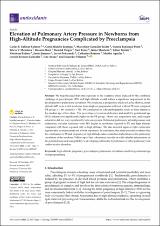Elevation of pulmonary artery pressure in newborns from high-altitude pregnancies complicated by preeclampsia

View/
Date
2023Author
Salinas-Salmón, Carlos E.
Murillo Jáuregui, Carla
Gonzales-Isidro, Marcelino
Espinoza-Pinto, Vannia
Mendoza, Silvia V
Ruiz, Rosario
Vargas, Ronald
Perez, Yuri
Montaño, Jaime
Toledo, Lilian
Badner, Abraham
Jiménez, Jesús
Peñaranda, Javier
Romero, Catherine
Aguilar, Martha
Riveros-Gonzales, Loyola
Arana, Ivar
Villamor, Eduardo
Metadata
Show full item recordAbstract
Abstract.
We hypothesized that fetal exposure to the oxidative stress induced by the combined challenge of preeclampsia (PE) and high altitude would induce a significant impairment in the development of pulmonary circulation. We conducted a prospective study in La Paz (Bolivia, mean altitude 3625 m) in which newborns from singleton pregnancies with and without PE were compared (PE group n = 69, control n = 70). We conducted an echocardiographic study in these infants at the median age of two days. The percentage of cesarean deliveries and small for gestational age (SGA) infants was significantly higher in the PE group. Heart rate, respiratory rate, and oxygen saturation did not vary significantly between groups. Estimated pulmonary arterial pressure and pulmonary vascular resistance were 30% higher in newborns exposed to PE and high altitude compared with those exposed only to high altitude. We also detected signs of right ventricular hypertrophy in infants subjected to both exposures. In conclusion, this study provides evidence that the combination of PE and pregnancy at high altitude induces subclinical alterations in the pulmonary circulation of the newborn. Follow-up of this cohort may provide us with valuable information on the potential increased susceptibility to developing pulmonary hypertension or other pulmonary and cardiovascular disorders.
